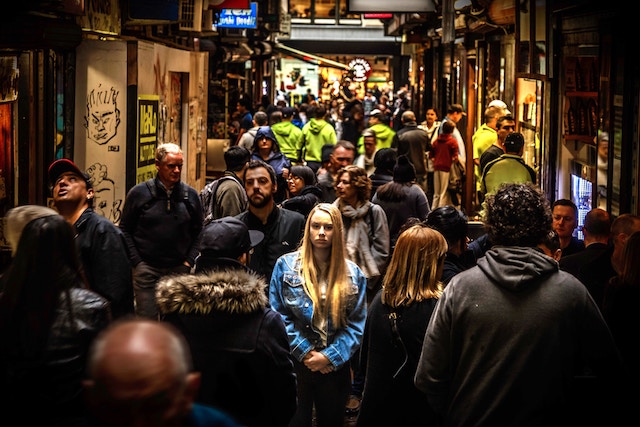
We love labels. They help us to more readily examine the nuanced world unfolding all around us.
Being a sensitive person in a chaotic world can be disorienting and disillusioning. Oh, how relieved I was when I came across the term empath to describe the waves of emotions I grappled with on a daily basis. The label felt like a warm blanket; I was finally swaddled in a safe cocoon, protected from the negative energy in the world. What a break.
Labels can provide comfort in an unpredictable world in which pain and suffering are a constant. As humans, we hurt each other, sometimes unknowingly, because we are hurt.
When we feel pain, it can be easy to label the perpetrator as a narcissist or abuser. It gives us comfort to ascribe a label to a person’s behavior and contextualize our behavior in contrast. If our former partner is narcissistic, it only stands to reason that we are the opposite—empathic.
However, the danger in fixating on these kinds of labels is that we fail to recognize our own complicity in the situation.
Admittedly, I am one to desperately type a list of my own neuroses into a Google search at 2:00 a.m. It is my favorite sleep-evading activity. I put a lot of stock in the internet to tell me I am normal.
What I now realize is that in looking to labels to define my experience, I was naval-gazing. I felt pain so intensely because of my own propensity for empathy that I became disillusioned with others. Sure, a label helped me understand and navigate my plight of taking on other’s energy.
But, by fixating on myself so intently, I did two things:
1. I began to see myself as removed from the world, in possession of some mystical insight to which others did not have access.
2. I forgot about other people because I was too invested in looking inward.
The label empath helped me get away with these indulgent processes—narcissistic tendencies.
I am not discounting the possibility that empaths are out there, feeling heightened emotions and sensing others’ energy at a profound level. I feel it too. While I regularly have the desire to cocoon back into the cozy empath label, I know that in doing so, I come dangerously close to a foray into narcissism wherein I can use it as an excuse for my self-centered behavior.
I am not suggesting that we dismiss labels completely. Labels are helpful in allowing us to understand the extremes we can attain as human beings. And when we understand the boundaries, we are better able to find middle ground.
Today, I sit here after a spat with my partner. Out of feelings of hurt and rejection, I acted out. I am reflecting on the changes I can make to quell my urge toward the extremes and straddle the line between empathy and self-involvement.
While I have not yet figured it all out (it’s a process isn’t it?), here are a few techniques I have picked up along the way.
Cultivate Mindfulness: Being mindful and living in the moment, as someone who has a tendency to be acutely aware of others, can support us to engage in joy and laughter while managing the inclination toward hyper-vigilance.
I know that when I am not practicing meditation, my quirks flare up. I become extremely aware of everything around me, and I get overloaded. When this happens, I tend to shift inward, taking in others’ energy and ruminating on past hurts. I cannot live in the moment, because I am too busy picking apart every interaction I have and ascribing meaning to it. While I know that there is strength in being perceptive and sensitive, it is important to be attentive of the self-indulgence of making every interaction overly significant in what it means to me.
Cultivating mindfulness leads to more genuine relationships and facilitates a shift toward the shared interaction in the present moment, rather than a heightened focus on our own emotions in relation to another person’s energy. Being mindfully aware can help an empathic person open up and lean into an experience rather than turning to the “safety” of their ruminating mind.
Practice Tonglen: Tonglen is the Tibetan Buddhist practice of giving and taking. The technique, as described by Chögyam Trungpa in Training the Mind and Cultivating Loving-Kindness, is a process of breathing in the bad and breathing out the good.
When I first read about this practice, I felt it was futile: how could an empath draw in negative energy while returning the good? It was nightmarish to consider being surrounded by energy vampires and those who would pulsate negative energy, leaving me to sop it up like a dry sponge.
But, in an effort to develop healthy practices, I started to experiment with Tonglen. I purposefully went to a bar to insert myself into a social setting. A woman approached me and began to tell me about her day. She described the fight she had had with her partner and the ensuing police involvement. Instead of recoiling into myself, I was intentional about creating space for empathy: listening to her intently and greeting her stories with love and compassion. What I began to notice was that as she opened up, so did I.
Normally an interaction like this would have left me drained by the end the night, but the intentionality behind Tonglen places a frame around this type of empathy and assists me in understanding that I can be compassionate toward people without feeling zapped.
As I continue my Tonglen practice, I have started to notice that people enjoy being around me more when I am outwardly empathic, rather than being aloof and seemingly unfeeling, which were common coping mechanisms when I felt overloaded. By practicing Tonglen, I am no longer holding negativity inside me; rather, I am converting it into positivity and breathing it out into the world.
Shed Attachment to Labels: The label empath came to me when my life went sideways. My social work career was falling apart. I was burnt out. I had ended my five-year relationship with a loving partner, and I was working toward a Master’s degree. Everything began to crash when I quit my Master’s and returned to my hometown. I was depressed and struggling with alcohol use. While suggesting that I was at rock bottom may be a bit of a stretch, I was definitely at a low point.
At this time, it was helpful to label my experience. Without a label, it seemed out of my control, like I was flailing. I fluctuated between various labels. Was I bipolar or did I have borderline personality disorder? Was it alcoholism I struggled with, or was I an empath, trying to find my place in the world? Empath was decidedly the easiest to swallow, and it was in line with my life-long narrative of being described as “too sensitive.” By grasping on to this label, I was able to make sense of my experience, or at least contain it in a neat little box.
However, the problem is that when we use one word to encapsulate behavior or experience, we limit our capacity for dialogue. I exalted my sensitivity without acknowledging my own problematic behaviors, closing myself off to critique or even help from others who cared about me. The reality is that we all have the propensity to access extremes and embody labels, but in doing so, we run the risk of becoming alienated from others, and possibly ourselves.
I know that when I label myself as empath, I tend to harden and close myself off from the world. And while that label served a purpose at one time in my life, to support me through an understanding of my identity in the world, I am ready to shed the comfort of the cocoon.
Pema Chödrön suggests that when we are vulnerable and tender, we experience the soft spot. When we are able to lean into this soft spot, we can access both pain and love—the very essence of life. When we become too timid to access this soft spot, we limit our experiences of life, and when we step too readily into our embrace of labels, we run the risk of embodying ego, which only serves to cover up the soft spot.
If we hope to embody the role of a healer and be of benefit to the world, we must learn to navigate these extremes and find a middle ground—without the cocoon.
~
~
Author: Cathy Boyce
Image: Mike Wilson/Unsplash
Editor: Callie Rushton
Copy Editor: Yoli Ramazzina
Social Editor: Catherine Monkman

 Share on bsky
Share on bsky




Read 12 comments and reply